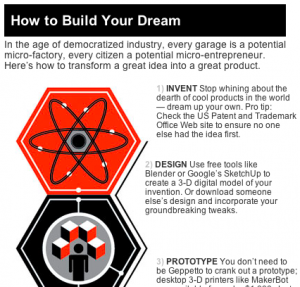THE DIO ECONOMY - DO IT OURSELVES
/The DIO Economy - Do It Ourselves
Chris Anderson (Editor-in-Chief of Wired Magazine) presents a spectacular cover story on "The New Industrial Revolution." The teaser reads:
The factory, the investors, the workers -- obsolete. In the age of DIY manufacturing, all you need is a garage and a great idea.
He opens with an example of a crowdsourced car:
Local Motors will officially release the Rally Fighter, a $50,000 off-road (but street-legal) racer. The design was crowdsourced, as was the selection of mostly off-the-shelf components, and the final assembly will be done by the customers themselves in local assembly centers as part of a “build experience.” Several more designs are in the pipeline, and the company says it can take a new vehicle from sketch to market in 18 months, about the time it takes Detroit to change the specs on some door trim. Each design is released under a share-friendly Creative Commons license, and customers are encouraged to enhance the designs and produce their own components that they can sell to their peers.
The Rally Fighter is a great example and raises the possibility of crowdsourcing for complicated systems. ...but then the article goes into overdrive:
Here’s the history of two decades in one sentence: If the past 10 years have been about discovering post-institutional social models on the Web, then the next 10 years will be about applying them to the real world. This story is about the next 10 years. Transformative change happens when industries democratize, when they’re ripped from the sole domain of companies, governments, and other institutions and handed over to regular folks. The Internet democratized publishing, broadcasting, and communications, and the consequence was a massive increase in the range of both participation and participants in everything digital — the long tail of bits.
The article is part economics lesson, part how-to. Chris includes his own story, describing the founding of DIY Drones, a community site focused on amateur Unmanned Aerial Vehicles (UAVs). Within the community, he met like-minded and skilled collaborators and now markets autopilots and other related products. He includes great detail throughout, including tools and production outsourcing links.
We need to get our minds around the possibilities of this new industrial revolution. Chris Anderson and others have focused on D-I-Y (Do It Yourself), but I think it's more than that. I see this new approach as D-I-O (Do It Ourselves). Each of his examples highlights the value of collaboration. These are not stories of lone inventors (except for his description of professor Bob Kearns' invention of intermittent windshield wipers -- but he apparently goes mad -- so much for the lone inventor...).
My own interests are around how to support DIO organization through my teaching and research. In an earlier post, I claimed that "Recruiting, Knowledge, Evaluation, Tools, and Market seem to be five foundational ways Web 2.0 supports innovation." Now I realize that DIO is more than about just innovation. DIO seems to be providing the foundations for what Anderson calls small batch entrepreneurship (with credit to blogger Jason Kottke). A new industrial revolution.
I look forward to your comments as I think out loud. --- For a different take on the value of crowdsourcing, please see Sarah Cove's (for Wired News) Interview of Douglas Rushkoff What Does Crowdsourcing Really Mean. Soon: A review of Cory Doctorow's Makers (free download):
Perry and Lester invent things—seashell robots that make toast, Boogie Woogie Elmo dolls that drive cars. They also invent entirely new economic systems, like the “New Work,” a New Deal for the technological era. Barefoot bankers cross the nation, microinvesting in high-tech communal mini-startups like Perry and Lester’s. Together, they transform the country, and Andrea Fleeks, a journo-turned-blogger, is there to document it.








